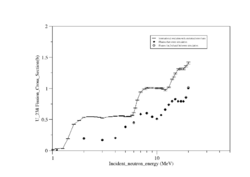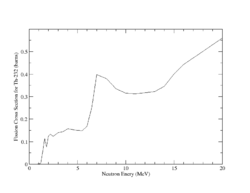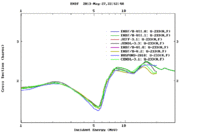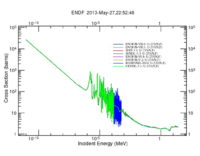Difference between revisions of "Induced Neutron Fission Fragment"
| Line 26: | Line 26: | ||
== Induced Neutron Fission of U233 Cross Sections(U-238 or Th-232)=== | == Induced Neutron Fission of U233 Cross Sections(U-238 or Th-232)=== | ||
| − | The definition of induced neutron fission cross section is the probability of occurrence of a fission interaction by an incident neutron that has a defined energy. Actinides and lanthanides generally have high fission cross sections compared to the rest of periodic table elements; but the cross section values changes as the incident neutron energy changes. For instance, U-235 has a high fission cross section for thermal neutrons compared to U-238 that has a high fission cross section for fast neutrons, U-233 has relatively high fission cross section values for almost all neutron energy range that starts with thermal neutron and ends with fast neutrons up to | + | The definition of induced neutron fission cross section is the probability of occurrence of a fission interaction by an incident neutron that has a defined energy. Actinides and lanthanides generally have high fission cross sections compared to the rest of periodic table elements; but the cross section values changes as the incident neutron energy changes. For instance, U-235 has a high fission cross section for thermal neutrons compared to U-238 that has a high fission cross section for fast neutrons, U-233 has relatively high fission cross section values for almost all neutron energy range that starts with thermal neutron and ends with fast neutrons up to more than 50 MEV as shown in the following figure. |
[[File:U-233_fissionxsection_0.01-100MeV.gif |200px]] | [[File:U-233_fissionxsection_0.01-100MeV.gif |200px]] | ||
Revision as of 03:16, 27 March 2013
Neutron energy: types and spectra
Neutron are classified into four types depending on their energy, each type has energy range which may change from one reference to another. The following table shows the types of neutrons, their energy range, and common detective materials.
| Neutron Type | Energy Range | Common detective material(s) |
| Cold Neutrons | He-3 | |
| Thermal Neutrons | Be-4, Li-6 | |
| Epithermal Neutrons | ||
| Fast Neutrons | U-238, Th-232 |
Neutron Emission
Induced Neutron Fission of U233 Cross Sections(U-238 or Th-232)=
The definition of induced neutron fission cross section is the probability of occurrence of a fission interaction by an incident neutron that has a defined energy. Actinides and lanthanides generally have high fission cross sections compared to the rest of periodic table elements; but the cross section values changes as the incident neutron energy changes. For instance, U-235 has a high fission cross section for thermal neutrons compared to U-238 that has a high fission cross section for fast neutrons, U-233 has relatively high fission cross section values for almost all neutron energy range that starts with thermal neutron and ends with fast neutrons up to more than 50 MEV as shown in the following figure.
they are tow types of fission cross sections; microscopic and macroscopic fission cross section.
The cross section is defined by the following equation :<ref name="Ahmed"/>
where
Where is the number incident particle per uni area per unit time, dN is the average number of particles per unit time that interacted per unit solid angle, and is the solid angle. Since the cross section has an area unit (barn), some authors define this quantity as the area to which the particle is exposed to make an interaction. <ref name="Ahmed">Syed Ahmed, Physics and Engineering of Radiation Detection (Academic Press 2007) </ref> The cross section values are represented as a function of energy that gives the value of the cross section for each energy value and shows the resonance peaks. A theoretical description of the neutron fission cross section curve is not available, but statistically it is possible to evaluate the parameters for an assumption that describes part of the cross section curve within a certain error.<ref name="Hyde"/>
Neutron fission is one of the interactions that commonly takes place spontaneously or under certain experimental conditions. An incident neutron depositing sufficient energy in a nucleus to enable the nucleus to overcome the Coulomb barrier will cause the nucleus to split into fragment ligher nuclei (fragments) and particles. The new products interact with the surrounding medium depending on their energy and the type of the medium that contains them.
Both U-238 and Th-232 are members of the actinides group. They are characterized by relatively high neutron fission cross sections for fast neutrons with fission thresholds above the thermal neutron energy. The fission reaction in both elements is expected to eject 1-2 neutrons when the incident neutron energy is between 5-10 MeV as shown in Fig.9 and Fig.10.
 |

|
| Fig.9 U 238 fission cross section | Fig.10 Th 232 fission cross section <ref name="endf_Th_232_JEFF1.3">http://www.nndc.bnl.gov/exfor/servlet/E4sMakeE4 </ref> |

